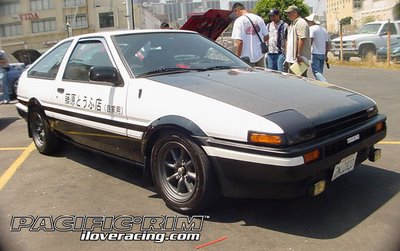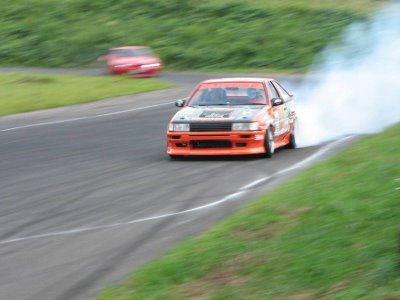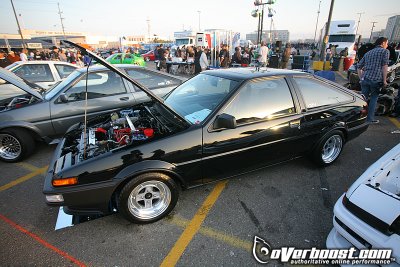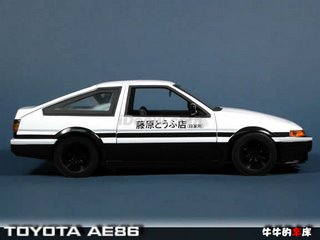 The Toyota Corolla Levin/Sprinter Trueno (AE86) is a small, lightweight coupe introduced by Toyota in 1983 as part of the fifth generation Toyota Corolla line-up. For the purpose of brevity, the insider-chassis code of "AE86" is used describe the whole range. The main difference between the Levin and Trueno is that the former has fixed-headlights whilst the latter has pop-up headlights; the export Corolla name covers both variations. The AE86 (along with the lower spec AE85 versions) was rear wheel drive (unlike the front wheel drive AE82 models), and is said to be the last rear-drive car of its type, at a time when most passenger cars were being switched to front-drive. The AE86 was replaced in 1987 by the front wheel drive AE92 Corolla/Sprinter range. The car was also known as the Hachi-Roku(ハチロク) (the numbers "eight" (hachi, ハチ) and "six" (roku, ロク) in Japanese).
The Toyota Corolla Levin/Sprinter Trueno (AE86) is a small, lightweight coupe introduced by Toyota in 1983 as part of the fifth generation Toyota Corolla line-up. For the purpose of brevity, the insider-chassis code of "AE86" is used describe the whole range. The main difference between the Levin and Trueno is that the former has fixed-headlights whilst the latter has pop-up headlights; the export Corolla name covers both variations. The AE86 (along with the lower spec AE85 versions) was rear wheel drive (unlike the front wheel drive AE82 models), and is said to be the last rear-drive car of its type, at a time when most passenger cars were being switched to front-drive. The AE86 was replaced in 1987 by the front wheel drive AE92 Corolla/Sprinter range. The car was also known as the Hachi-Roku(ハチロク) (the numbers "eight" (hachi, ハチ) and "six" (roku, ロク) in Japanese).Motor
 The AE86 was available with a fuel-injected 4-cylinder twin-cam 1587 cc 4A-GEU engine in Japan and Europe which was also used in the first-generation Toyota MR2 (AW11). This engine had a maximum power output of 130 PS (97 kW) and 103 ft·lbf (140 N·m) of torque in standard form. The AE86 came with a 5-speed manual gearbox, and later came with the option of an automatic. The 4A-GE engines used in the AE86 and AW11 were equipped with T-VIS (Toyota Variable Induction System). The AE86 had an optional Limited Slip Differential (LSD).In North America, a modified 4A-GEC engine was used to comply with California emissions regulations. Power was rated at 112 bhp (84 kW), and 100 ft·lbf (136 N·m) of torque.The AE86 used ventilated disc brakes. The car was equipped with independent coil spring suspension at the front, and beam-axle coil springs for the rear.The AE85 models came with a less-powerful 1452 cc SOHC carburettor 3A-U engine without the LSD and were equipped with rear drum brakes. Lower-spec American AE86 SR5 models used the 1587 cc 4A-C SOHC unit, did not have an optional LSD, and had rear drum brakes.Models equipped with the 4A-GE engine received a 6.7" rear differential, while 3A-U, 4A-U, and 4A-C models received a smaller, weaker, 6.38" rear differential.In North America the AE86 SR5 (4A-C equipped) had an optional automatic transmission, though the GT-S model (with the 4A-GE DOHC engine) only came with a standard 5-speed manual gearbox.
The AE86 was available with a fuel-injected 4-cylinder twin-cam 1587 cc 4A-GEU engine in Japan and Europe which was also used in the first-generation Toyota MR2 (AW11). This engine had a maximum power output of 130 PS (97 kW) and 103 ft·lbf (140 N·m) of torque in standard form. The AE86 came with a 5-speed manual gearbox, and later came with the option of an automatic. The 4A-GE engines used in the AE86 and AW11 were equipped with T-VIS (Toyota Variable Induction System). The AE86 had an optional Limited Slip Differential (LSD).In North America, a modified 4A-GEC engine was used to comply with California emissions regulations. Power was rated at 112 bhp (84 kW), and 100 ft·lbf (136 N·m) of torque.The AE86 used ventilated disc brakes. The car was equipped with independent coil spring suspension at the front, and beam-axle coil springs for the rear.The AE85 models came with a less-powerful 1452 cc SOHC carburettor 3A-U engine without the LSD and were equipped with rear drum brakes. Lower-spec American AE86 SR5 models used the 1587 cc 4A-C SOHC unit, did not have an optional LSD, and had rear drum brakes.Models equipped with the 4A-GE engine received a 6.7" rear differential, while 3A-U, 4A-U, and 4A-C models received a smaller, weaker, 6.38" rear differential.In North America the AE86 SR5 (4A-C equipped) had an optional automatic transmission, though the GT-S model (with the 4A-GE DOHC engine) only came with a standard 5-speed manual gearbox.Estilos de carrocerías
Both the Levin and Trueno variants were offered with either a 2-door coupe or 3-door lift back (sometimes called hatchback) body style. Both the Levin and Trueno were generally identical, apart from fixed, rectangular headlights on the Levin and pop-up headlights on the Trueno. Minor bodywork changes were made in 1986 which resulted in different tail lights for both Levin and Trueno models, along with the coupe and hatchback styles. The models sold between 1983–1985 are commonly referred to as "Zenki" and the models sold from 1986–1987 are referred to as "Kouki". Quoted power output was 122 bhp.
Both the Levin and Trueno variants were offered with either a 2-door coupe or 3-door lift back (sometimes called hatchback) body style. Both the Levin and Trueno were generally identical, apart from fixed, rectangular headlights on the Levin and pop-up headlights on the Trueno. Minor bodywork changes were made in 1986 which resulted in different tail lights for both Levin and Trueno models, along with the coupe and hatchback styles. The models sold between 1983–1985 are commonly referred to as "Zenki" and the models sold from 1986–1987 are referred to as "Kouki". Quoted power output was 122 bhp.
Especificaciones del AE86
Japan, the DOHC 4A-GEU AE86 was offered in GT-APEX or GTV trims as the Corolla Levin or Sprinter Trueno, with SOHC 3A-U AE85 version sold in a variety of trims including SR, GT, et cetera. In America, the top-spec DOHC 4A-GEC AE86 was sold as the Corolla GT-S with the SOHC 4A-C AE86 bearing the Corolla SR5 tag, both versions sold with pop-up headlights only. Euro spec models were sold as the Corolla GT with DOHC engines and fixed Levin-style headlights. The Middle East received the same basic model as the North American market, with pop-up headlights and the regulated 5 mph (8 km/h) bumpers.Due to a light weight of around 940 kg, and over 120 bhp (89 kW) power, the car could reach a top speed of 120 mph (193 km/h), and could accelerate from 0–60 mph in 8.5 seconds in standard specification.

El AE86 en competencias
During its production life, the AE86 was a popular choice for showroom stock, Group A, and Group N racing, especially in rallying and circuit races. Even after production of the car was discontinued, many privateer teams still raced the AE86, and it is still is a popular choice for rallying and club races today. Part of the continued appeal of the AE86 for motorsports is its rear-drive configuration, a feature not available in most newer lightweight coupes. In Group A touring car races, the car either dominated the lower category where eligible or fought it out with Honda Civics or the later AE92s and AE101s whilst maintaining its competitiveness. In Ireland where rallying is considered one of the most popular forms of motorsport as organising regulations are more relaxed to that of other countries, the AE86 was popular when new, and is still so popular that teams will purchase cars from elsewhere in the UK due to local shortages. The AE86 is also popular for rally use in Finland, where the cars can be competitive in the F-Cup competition for normally-aspirated 2WD cars.
he semi-factory supported Kraft team entered a spaceframe Trueno at the JGTC with a 3S-GTE engine that came from a SW20 MR-2 Turbo producing about 300 hp as for the GT300 regulation in 1998. Despite being popular with the racefans, the car had minor success and was abandoned from use halfway through the 2001 season in favor of a newly delivered Toyota MR-S.
The rear wheel drive configuration, combined with the AE86's light weight (approximately 2300 lb (1043 kg) curb weight), balance and relatively powerful (and easy to tune) 4A-GEU4A-GEC engine made it popular among the Japanese hashiriya (street racers), many of whom raced in mountain passes (touge in Japanese) where the corners suited the AE86 best, especially on the downhill. Among those who utilized this car was Japanese racing legend Keiichi Tsuchiya, also known as the Dori-Kin ("Drift King"). Tsuchiya helped popularize the sport of drifting, which involves taking a car on a set of controlled slides through corners. The AE86's RWD configuration made it well suited to this kind of cornering, and currently the car is a mainstay of drift shows and competitions. In fact most of the D1GP drivers who have competed have owned an AE86. However, despite the car's racing and drifting legacy, many modern cars simply outclass its handling and power. Much of the car's clout in the car enthusiasts' world is due to subjective feelings about the experience behind the wheel and media popularization, not hard performance numbers or actual speed.
have competed have owned an AE86. However, despite the car's racing and drifting legacy, many modern cars simply outclass its handling and power. Much of the car's clout in the car enthusiasts' world is due to subjective feelings about the experience behind the wheel and media popularization, not hard performance numbers or actual speed.
he semi-factory supported Kraft team entered a spaceframe Trueno at the JGTC with a 3S-GTE engine that came from a SW20 MR-2 Turbo producing about 300 hp as for the GT300 regulation in 1998. Despite being popular with the racefans, the car had minor success and was abandoned from use halfway through the 2001 season in favor of a newly delivered Toyota MR-S.
The rear wheel drive configuration, combined with the AE86's light weight (approximately 2300 lb (1043 kg) curb weight), balance and relatively powerful (and easy to tune) 4A-GEU4A-GEC engine made it popular among the Japanese hashiriya (street racers), many of whom raced in mountain passes (touge in Japanese) where the corners suited the AE86 best, especially on the downhill. Among those who utilized this car was Japanese racing legend Keiichi Tsuchiya, also known as the Dori-Kin ("Drift King"). Tsuchiya helped popularize the sport of drifting, which involves taking a car on a set of controlled slides through corners. The AE86's RWD configuration made it well suited to this kind of cornering, and currently the car is a mainstay of drift shows and competitions. In fact most of the D1GP drivers who
 have competed have owned an AE86. However, despite the car's racing and drifting legacy, many modern cars simply outclass its handling and power. Much of the car's clout in the car enthusiasts' world is due to subjective feelings about the experience behind the wheel and media popularization, not hard performance numbers or actual speed.
have competed have owned an AE86. However, despite the car's racing and drifting legacy, many modern cars simply outclass its handling and power. Much of the car's clout in the car enthusiasts' world is due to subjective feelings about the experience behind the wheel and media popularization, not hard performance numbers or actual speed.
El AE86 en mangas y videojuegos
Animes y mangas
The Hachi-Roku is immortalized by manga artist Shuichi Shigeno in the hit manga/anime series Initial D, and this, in turn, led to a resurgence of interest in the car. The Trueno is driven by Takumi Fujiwara, whom delivers tofu for his father Bunta Fujiwara. A Levin variant is driven by one of Takumi's later rivals Wataru Akiyama. Takumi's friend Itsuki Takeuchi unintentionally buys a lower trim Corolla, a Levin AE85, thinking it's an AE86.
The Eight-Six can be found in other anime, including Ex-Driver, Tenjou Tenge, Over Rev, Azumanga Daioh, Dear Boys, School Rumble, Capeta, Transformers: Energon, and FLCL. Manga apperences include Beck and Shigeno's earlier work Tunnel Nuketara Sky Blue.
Videojuegos
Among some of the games that have featured the AE86 include:
Electronic Arts's Need for Speed: Underground 2 and Need For Speed Carbon (although under the American name Corolla GT-S)
Genki's Shutokou Battle and Kaido Battle (also known as Toky
 o Xtreme Racer)
o Xtreme Racer)Konami/Genki's Street Supremacy (AE86 Trueno Sprinter Twin Cam 16)
Konami's Racing Jam (AE86 Trueno Sprinter Twin Cam 16)
Microsoft's Forza Motorsport (Trueno only)
Namco's Street Racing Syndicate
Polyphony Digital's Gran Turismo 2, Gran Turismo 3: A-Spec, and Gran Turismo 4. (GT3 and GT4 includes a Shuichi Shigeno edition Trueno.)
Sega/Sega Rosso's Initial D Arcade Stage
Sega/Wow Entertainment's Sega GT and its followups, Sega GT 2002 and Sega GT Online (Trueno only)
Taito's Battle Gear and Side by Side series